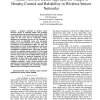370 search results - page 29 / 74 » Evolving neural network ensembles for control problems |
NCA
2007
IEEE
13 years 7 months ago
2007
IEEE
: Autonomous neural network systems typically require fast learning and good generalization performance, and there is potentially a trade-off between the two. The use of evolutiona...
TROB
2002
13 years 7 months ago
2002
A dual neural network is presented for the bi-criteria kinematic control of redundant manipulators. To diminish the discontinuity of minimum infinity-norm solutions, the kinematicc...
GECCO
2007
Springer
14 years 1 months ago
2007
Springer
Surrogate-Assisted Memetic Algorithm(SAMA) is a hybrid evolutionary algorithm, particularly a memetic algorithm that employs surrogate models in the optimization search. Since mos...
WCNC
2008
IEEE
14 years 2 months ago
2008
IEEE
A primary constraint in wireless sensor networks (WSNs) is obtaining reliable and prolonged network operation with power-limited sensor nodes. Most of the approaches to the energy ...
IJCNN
2008
IEEE
14 years 2 months ago
2008
IEEE
— The first-person-shooter Quake II is used as a platform to test neuro-visual control and retina input layouts. Agents are trained to shoot a moving enemy as quickly as possibl...

